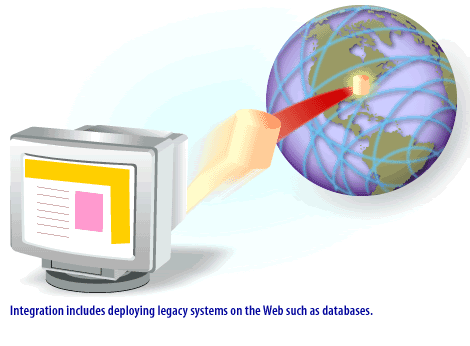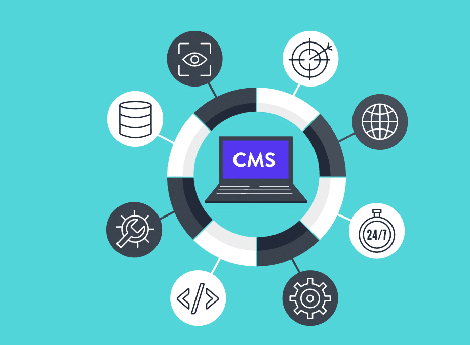| Lesson 7 | Infrastructure for e-commerce |
| Objective | Describe the Infrastructure required to implement e-commerce. |
Describe Infrastructure required to implement e-commerce
Numerous systems and tools must be in place to support e-commerce transactions from initial contact to order fulfillment and inventory management. To set up an e-commerce site, you need:
- A merchant system
- Security mechanisms for the hardware
- Security mechanisms to protect the customers
- Merchant System
Merchant systems facilitate online purchases and credit card transactions. They are comprised of components such as merchant servers and merchant software. A merchant account at a financial institution is required to handle credit card transactions. All the components are needed to facilitate credit card transactions, and as you may recall in our previous lesson on B2B sites, EDI (Electronic Data Interchange) enables secure transactions between banks of two businesses allowing payments to be exchanged electronically.
There are many hardware and software devices to protect the e-commerce hardware (the server), as well as the customer. A firewall is an example of a hardware security mechanism to protect the server; encryption is an example of software to protect the customer.
Business Support Mechanisms
There are other systems required to implement an e-commerce site.
These are not necessarily hardware or software, but support mechanisms.
One support mechanism involves customer relationship management (CRM). CRM integrates sales, marketing, customer support, engineering, and quality assurance through software, or a process, or both.
A modern Customer Relationship Management (CRM) system is a multifaceted platform designed to streamline and enhance interactions with customers across various touchpoints. The core components of a modern CRM system encompass a wide range of functionalities that integrate sales, marketing, customer support, and other business processes. Below are the key components:
You will learn about additional support mechanisms in the following series of images.
- Contact and Account Management:
- Customer Database: Centralized storage of customer and prospect information, including contact details, communication history, and account status.
- Interaction Tracking: Logs of all interactions with customers, such as calls, emails, meetings, and support tickets.
- Sales Force Automation (SFA):
- Lead Management: Tools to capture, track, and nurture leads through the sales pipeline.
- Opportunity Management: Management of potential sales deals, including forecasting and tracking progress.
- Quote and Order Management: Creation and management of sales quotes, orders, and invoices.
- Sales Analytics: Reports and dashboards to monitor sales performance and identify trends.
- Marketing Automation:
- Campaign Management: Planning, executing, and analyzing marketing campaigns across multiple channels.
- Email Marketing: Automated email campaigns with personalization and segmentation capabilities.
- Lead Scoring and Nurturing: Evaluating leads based on predefined criteria and automating follow-up actions.
- Marketing Analytics: Metrics and insights to assess campaign effectiveness and ROI.
- Customer Support and Service:
- Case Management: Tools to log, track, and resolve customer issues and service requests.
- Knowledge Base: A repository of information and solutions for common customer problems.
- Service Level Management: Monitoring and enforcing service level agreements (SLAs) to ensure timely support.
- Multi-Channel Support: Integration of various support channels, including phone, email, live chat, and social media.
- Analytics and Reporting:
- Real-Time Dashboards: Visual representations of key performance indicators (KPIs) across departments.
- Custom Reports: Ability to generate reports tailored to specific business needs.
- Predictive Analytics: Use of data analysis to forecast trends and customer behaviors.
- Workflow and Process Automation:
- Task Automation: Automating repetitive tasks like data entry, follow-up communications, and scheduling.
- Approval Processes: Streamlining approval workflows for quotes, discounts, and other sales activities.
- Notifications and Alerts: Automated reminders and alerts for important actions and deadlines.
- Collaboration Tools:
- Team Communication: Internal messaging systems, shared calendars, and collaborative workspaces.
- Document Management: Centralized storage and sharing of documents, proposals, and marketing materials.
- Integration with Collaboration Platforms: Connectivity with tools like Slack, Microsoft Teams, or Google Workspace.
- Mobile Access:
- Mobile Apps: Access to CRM functionalities through smartphones and tablets.
- Offline Access: Ability to view and update information without an internet connection, syncing when back online.
- Mobile Notifications: Real-time alerts and updates delivered to mobile devices.
- Integration Capabilities:
- API Access: Application Programming Interfaces (APIs) to connect with other software systems.
- Third-Party Integrations: Pre-built integrations with email clients, accounting software, ERP systems, and more.
- Data Import/Export: Tools to import data from external sources and export data for analysis or reporting.
- Customization and Scalability:
- Custom Fields and Modules: Ability to add custom data fields and create modules specific to business needs.
- User Interface Customization: Personalization of dashboards, views, and workflows.
- Scalability: Capability to handle growing amounts of data and users without performance degradation.
- Security and Data Management:
- Role-Based Access Control: Permissions and access levels based on user roles.
- Data Encryption: Protection of data both at rest and in transit.
- Compliance Management: Tools to ensure adherence to regulations like GDPR, HIPAA, and other data protection laws.
- Audit Trails: Logging of user activities for security and compliance monitoring.
- Artificial Intelligence (AI) and Machine Learning:
- Predictive Lead Scoring: Using AI to identify high-potential leads.
- Customer Segmentation: Automated grouping of customers based on behaviors and preferences.
- Chatbots and Virtual Assistants: AI-powered tools for customer interaction and support.
- Sentiment Analysis: Understanding customer emotions and feedback through data analysis.
- Social Media Integration (Social CRM):
- Social Listening: Monitoring brand mentions and customer feedback on social platforms.
- Engagement Tools: Responding to comments, messages, and reviews directly from the CRM.
- Social Analytics: Tracking the performance of social media campaigns and content.
- E-Commerce Integration:
- Order Tracking: Monitoring customer orders and shipment statuses.
- Shopping Cart Integration: Connecting CRM with online shopping platforms.
- Customer Purchase History: Recording and analyzing past purchases for upselling and cross-selling opportunities.
- Customer Data Management:
- Data Quality Tools: Deduplication, validation, and enrichment of customer data.
- Master Data Management: Maintaining a single source of truth for customer information.
- Data Import Wizards: Simplified tools for importing large datasets.
- Training and Support Resources:
- User Guides and Documentation: Comprehensive materials to assist users in navigating the CRM.
- Training Programs: Onboarding sessions, webinars, and tutorials.
- Customer Support: Access to help desks, support tickets, and customer service representatives.
- Feedback and Survey Tools:
- Customer Surveys: Tools to create and distribute surveys for feedback.
- Net Promoter Score (NPS) Tracking: Measuring customer loyalty and satisfaction.
- Feedback Analysis: Tools to interpret and act on customer feedback.
- Billing and Invoicing:
- Invoice Generation: Creating and sending invoices directly from the CRM.
- Payment Tracking: Monitoring payment statuses and history.
- Integration with Accounting Software: Seamless data flow between CRM and financial systems.
- Multi-Language and Multi-Currency Support:
- Globalization Features: Accommodating users and customers from different regions.
- Currency Conversion: Automatic updates of exchange rates for accurate financial tracking.
- Compliance and Regulatory Features:
- Consent Management: Recording customer consent for communications.
- Audit Compliance: Tools to prepare for and pass regulatory audits.
- Data Residency Options: Hosting data in specific geographic locations as per legal requirements.
CRM







Ecommerce Infrastructure - Quiz
Click the Quiz link below to test how well you understand e-commerce infrastructure.
Ecommerce Infrastructure - Quiz
In the next lesson, you will identify issues associated with conducting business globally on the Internet.
Ecommerce Infrastructure - Quiz
In the next lesson, you will identify issues associated with conducting business globally on the Internet.